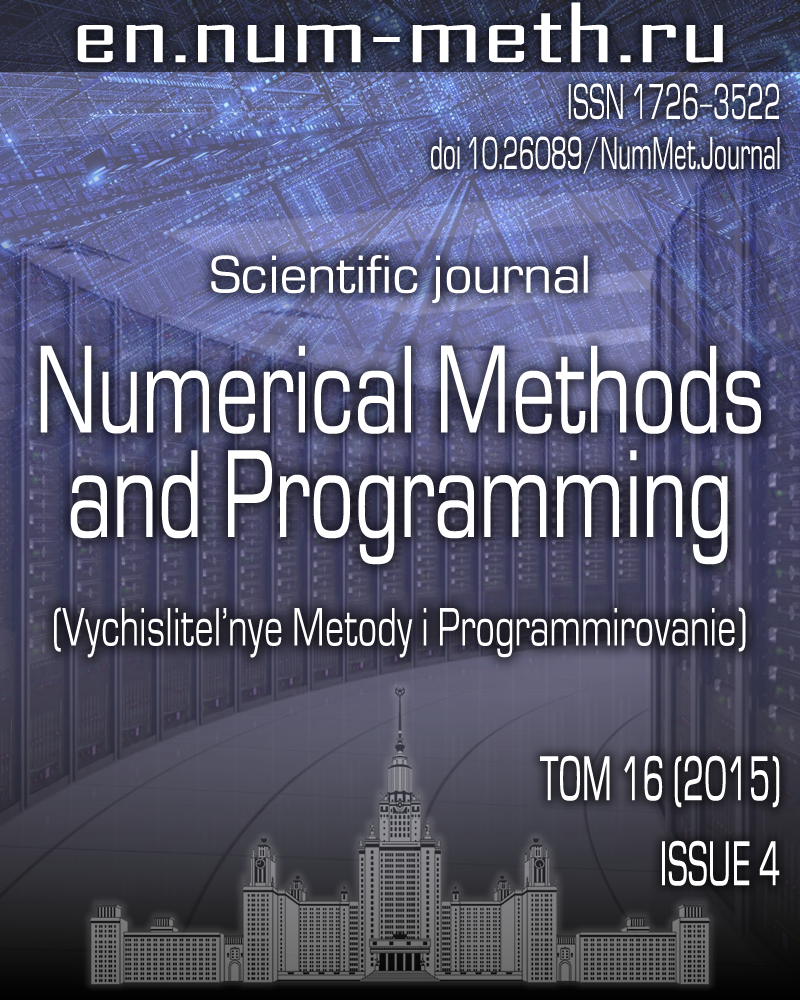DOI: https://doi.org/10.26089/NumMet.v16r449
Adaptive unstructured mesh generation methods for hydrogeological problems
Keywords:
mesh generator
hydrogeological modeling
triangular-prismatic meshes
octree meshes
Abstract
Two mesh generators embedded in the GeRa code for the solution of groundwater flow and radionuclide transport problems are discussed. The first one is a triangular-prismatic generator with the ability of cell degeneration; the second one is the polyhedral octree mesh generator implementing the cut-cell technology. These generators allow the user to automatically create conformal polyhedral adaptive grids in three-dimensional geological domains with consideration of complex boundaries, top and bottom geological layer surfaces, pinch-outs, and geological heterogeneities.
Published
2015-09-13
Issue
Section
Section 1. Numerical methods and applications
References
- I. V. Kapyrin, S. S. Utkin, and Yu. V. Vasыilevskii, “Concept of the Design and Application of the GeRa Numerical Code for Radioactive Waste Disposal Safety Assessment,” Voprosy Atom. Nauki Tekh. Ser.: Math. Model. Phys. Proc., No. 4, 44-54 (2014).
- Yu. Vasilevskii, A. Vershinin, A. Danilov, and A. Plenkin, “A Technology of Constructing Tetrahedral Meshes for Domains Given in a CAD System,” in Matrix Methods and Technologies for Solving Large Problems (Inst. Numer. Math. Russ. Acad. Sci., Moscow, 2005), pp. 21-32.
- A. Yu. Chernyshenko, “Generation of Octree Meshes with Cut Cells in Multiple Material Domains,” Vychisl. Metody Programm. 14, 229-245 (2013).
- M. L. Sidorov and V. A. Pronin, “Unstructured Prismatic Discretization of Complex Geological Structures in the Parallel Mode,” Voprosy Atom. Nauki Tekh. Ser.: Math. Model. Phys. Proc., No. 1, 47-55 (2015).
- H.-J. G. Diersch, FEFLOW Finite Element Subsurface Flow and Transport Simulation System (WASY GmbH, Berlin, 2005).
- S. Panday, C. D. Langevin, R. G. Niswonger, et al., MODFLOW-USG Version 1: An Unstructured Grid Version of MODFLOW for Simulating Groundwater Flow and Tightly Coupled Processes Using a Control Volume Finite-Difference Formulation , U.S. Geological Survey Techniques and Methods.
http://water.usgs.gov/ogw/mfusg/#more . Cited October 5, 2015. - P. L. George, “Automatic Mesh Generation and Finite Element Computation,” Handb. Numer. Anal. 4, 127-148 (1996).
- A. A. Danilov, “Unstructured Tetrahedral Mesh Generation Technology,” Zh. Vychisl. Mat. Mat. Fiz. 50 (1), 146-163 (2010) [Comput. Math. Math. Phys. 50 (1), 139-156 (2010)].
- V. L. Freedman, X. Chen, S. Finsterle, et al., “A High-Performance Workflow System for Subsurface Simulation,” Environ. Model. Softw. 55, 176-189 (2014).
- Y. Livnat, H.-W. Shen, and C. R. Johnson, “A Near Optimal Isosurface Extraction Algorithm Using the Span Space,” IEEE Trans. Vis. Comput. Graphics 2 (1), 73-84 (1996).
- C.-C. Ho, F.-C. Wu, B.-Y. Chen, et al., “Cubical Marching Squares: Adaptive Feature Preserving Surface Extraction from Volume Data,” Comput. Graphics Forum 24 (3), 537-545 (2005).
- Z. Wu and J. M. Sullivan, “Multiple Material Marching Cubes Algorithm,” Int. J. Numer. Meth. Eng. 58 (2), 189-207 (2003).
- B. Yahiaoui, H. Borouchaki, and A. Benali, “Hex-Dominant Mesh Improving Quality to Tracking Hydrocarbons in Dynamic Basins,” Oil Gas Sci. Technol. 69 (4), 565-572 (2014).
- HEXPRESS: Unstructured Full-Hexahedral Meshing.
http://www.numeca.com/. Cited October 5, 2015. - MeshGems: Suite of Reliable Meshing Software Components for High-Demanding CAD/CAE Developers.
http://meshgems.com/volume-meshing-meshgems-hexa.html . Cited October 5, 2015. - Hexotic CAD/CAE Developers.
http://www-roc.inria.fr/gamma/gamma/Membres/CIPD/Loic.Marechal/Research/Hexotic.html . Cited October 5, 2015. - ANSYS ICEM CFD.
http://www.ansys.com/Products/Other+Products/ANSYS+ICEM+CFD . Cited October 5, 2015.


